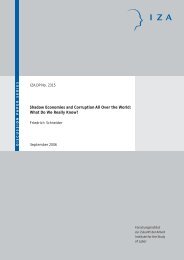Gender Differences in Education Tuomas Pekkarinen - Index of - IZA
Gender Differences in Education Tuomas Pekkarinen - Index of - IZA
Gender Differences in Education Tuomas Pekkarinen - Index of - IZA
Create successful ePaper yourself
Turn your PDF publications into a flip-book with our unique Google optimized e-Paper software.
and natural experiments on class size reductions do show that reduc<strong>in</strong>g class size may<br />
improve student achievement and is <strong>of</strong>ten effective <strong>in</strong> reduc<strong>in</strong>g gender gaps as well.<br />
The most carefully studied experiment <strong>in</strong> class size reductions is the STAR experiment which<br />
randomly assigned students and teachers to classes <strong>of</strong> different sizes with<strong>in</strong> schools <strong>in</strong><br />
Tennessee. The short-term effects <strong>of</strong> this experiment on test scores were studies by Krueger<br />
(1999) whereas Chetty et al (2011) provide an analysis <strong>of</strong> long-term outcomes such as<br />
completed school<strong>in</strong>g and earn<strong>in</strong>gs. Interest<strong>in</strong>gly these studies show that reduc<strong>in</strong>g class size by<br />
one third improved both the short-term (test scores) and long-term (completed school<strong>in</strong>g)<br />
outcomes more for men than for women. It is not clear, however, whether the class size<br />
reduction was effective <strong>in</strong> target<strong>in</strong>g the long-term outcomes <strong>of</strong> men at the lower end <strong>of</strong> the<br />
achievement distribution. Whereas the results <strong>in</strong> Krueger (1999) suggest that the experiment<br />
also improved the test scores <strong>of</strong> students from poor families (students receiv<strong>in</strong>g free school<br />
meals), Chetty et al (2011) report that the long-term effects were stronger for high <strong>in</strong>come<br />
students.<br />
Fredriksson et al (2011) show similar results from a natural experiment <strong>in</strong> Sweden where<br />
adm<strong>in</strong>istrative rules create exogenous changes <strong>in</strong> class sizes. Us<strong>in</strong>g this variation, the authors<br />
f<strong>in</strong>d that class size reductions, also <strong>in</strong> this case, have stronger effects on men but at the same<br />
time they <strong>in</strong>crease the achievement gaps between students from rich and poor families.<br />
Hence, even though it seems that reduc<strong>in</strong>g class size may be an effective tool <strong>of</strong> reduc<strong>in</strong>g<br />
gender gaps <strong>in</strong> achievement, we cannot be sure whether they are successful <strong>in</strong> target<strong>in</strong>g the<br />
achievement <strong>of</strong> poorly perform<strong>in</strong>g males which should be the ma<strong>in</strong> target group, if we are<br />
concerned about the gender gap.<br />
30
















